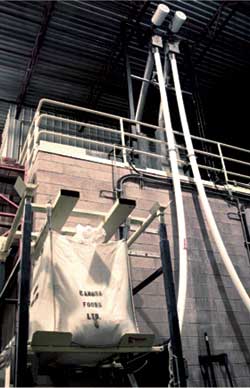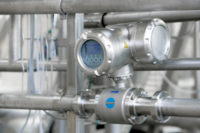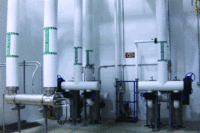
An operator’s command at a central PC initiates addition of a pre-selected weight of salt and whey powder from 2,200 lb bulk bags from two bulk bag dischargers, through two flexible screw conveyors to one of two mixing tanks inside the room. Agitators in the tanks automatically cycle on and off. Pumps admit the precise volume of water, while other pumps transfer the precise volume of prepared milk through a heat treating process to a finished milk tank. The ingredients remain enclosed from bulk bag to mixing tank, preventing contamination.
Key to batching of the salt and whey powder is an automated process jointly engineered by Canbra Foods and Flexicon Corp., Bethlehem, Pa. Outside of the room, each of two 15-ft high bulk bag dischargers, under loss-of-weight control, unloads whey powder or salt into two stainless steel hoppers. A flexible screw conveyor elevates the ingredient to a height sufficient for gravity feeding through two 5-ft high diverter valves. Inside of the room, each valve splits into two stainless steel chutes feeding either of two mixing tanks.
Pneumatically activated Flow-Flexer plates at the bottom of the bag promote flow of the ingredient by massaging the lower side walls of the bag at pre-set intervals. As the bag empties, the stroke of the plates increases, raising the side walls in a ‘V’ shape, promoting complete product discharge. A pneumatic turbine vibrator in the hopper promotes flow into the flexible screw conveyor intake adapter.
As a bag discharges, load cells supporting the entire frame and bag transmit weight-loss signals to a controller, which shuts off the flexible screw conveyor once the set batch weight has been discharged. The controller passes information to and from the plant SCADA system at a central PC, which also communicates with the PLC controlling the agitators and pumps inside the room, as well as 13 other PLC’s in the plant. At the central PC, an operator enters commands for the milk preparation through RSBatch software, under the ISA S88 batching standard. The software collects data for tracking each batch, compiling batch records, and identifying trends and deviations.
Product contact surfaces of the flexible screw conveyors are constructed and finished to sanitary standards. Each conveyor moves the ingredient through an outer tube that encloses a rugged, flexible stainless steel screw—the only moving part contacting material. The conveyor has no cracks or crevices that can trap particles or prevent thorough cleaning. A stainless steel flat wire spiral, imparting greater directional force than round wire spirals, conveys the fine (200-mesh particle size), semi-free-flowing whey powder. A round stainless steel screw transports the 40-mesh particle size salt. Both ingredients are hygroscopic.
The automated batching system replaces manual dumping of the ingredients into a pre-mixer on an open processing floor. The plant needed to dispose of 100 empty bags per day. Inevitably, spillage occurred, and the pre-mixer occasionally received inaccurate amounts of ingredients. The potential arose for injury from lifting bags. Manual operations also included activating the mixer and pumps and recording data, subjecting the process to human error.
To produce margarine, the prepared milk is blended with canola oil, Canbra Foods’ main product. The oil preparation phase, also under the plant PLC control system, is largely automated, but Canbra Foods may upgrade it in several years, utilizing a similar loss-of-weight bulk bag batching system for wet and dry blending of ingredients.
Flexicon Corp.
www.flexicon.com
888/353-9426
sales@flexicon.com

